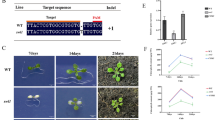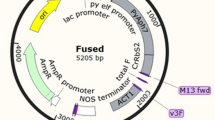Abstract
Eyes absent (Eya) is a highly conserved transcription cofactor and protein phosphatase that regulates multiple developmental processes throughout the metazoans. It is a dual function protein, working as a transcription factor in the nucleus and as a tyrosine phosphatase in the cytoplasm. In this study, we isolated EYA-1 of Caenorhabditis elegans, the only homolog of Eyes absent, and set up an effective feeding-based RNAi (RNA interference) against the gene. We found that knockdown of EYA-1 decreased heat and oxidative stress tolerance and accelerated the onset of paralysis mediated by Aβ1-42 proteotoxicity and polyQ. Under heat stress (35°C), EYA-1 knockdown shortened the mean lifespan by 16.8%, which could be attributed to decrease in heat shock protein-16.2 (hsp-16.2) expression. Under oxidative stress, EYA-1 knockdown could shorten the mean lifespan by 18.7%, which could be attributed to intracellular ROS accumulation and the decrease of superoxide dismutase-3 (sod-3) protein expression. Moreover, EYA-1 knockdown animals also showed increased lipofuscin accumulation under oxidative stress. Further studies demonstrated that EYA-1 knockdown could not inhibit daf-16 nuclear accumulation in wild-type worms in response to stress. On the other hand, EYA-1 deficiency did not further reduce stress resistance of daf-16 mutants, which are stress sensitive. Quantitative real-time PCR results also showed that the expression of two daf-16 target genes, hsp-12.3 and sod-3, was downregulated in EYA-1 RNAi-treated worms under stress. All this evidence indicates EYA-1 is required for stress resistance of worms, and it might act downstream of daf-16 to regulate expression of stress resistance-associated genes.
Similar content being viewed by others
Abbreviations
- GFP:
-
green fluorescent protein
- HSP-16.2:
-
heat-shock protein
- NGM:
-
nematode growth medium
- RNAi:
-
RNA interference
- ROS:
-
reactive oxygen species
References
Bonini, N. M., Leiserson, W. M., and Benzer, S. (1993) The eyes absent gene: genetic control of cell survival and differentiation in the developing Drosophila eye, Cell, 72, 379–395.
Rayapureddi, J. P., Kattamuri, C., Steinmetz, B. D., Frankfort, B. J., Ostrin, E. J., Mardon, G., and Heqde, R. S. (2003) Eyes absent represents a class of protein tyrosine phosphatases, Nature, 426, 295–298.
Tootle, T. L., Silver, S. J., Davies, E. L., Newman, V., Latek, R. R., Mills, I. A., Selenqut, J. D., Parlikar, B. E., and Rebay, I. (2003) The transcription factor Eyes absent is a protein tyrosine phosphatase, Nature, 426, 299–302.
Bessarab, D. A., Chong, S. W., and Korzh, V. (2004) Expression of zebrafish six1 during sensory organ development and myogenesis, Dev. Dyn., 230, 781–786.
Xu, P. X., Woo, I., Her, H., Beier, D. R., and Maas, R. L. (1997) Mouse eya homologues of the Drosophila eyes absent gene require Pax6 for expression in lens and nasal placode, Development, 124, 219–231.
Tadjuidje, E., and Hegde, R. S. (2012) The Eyes absent proteins in development and disease, Cell Mol. Life Sci., 70, 1897–1913.
Zou, D., Silvius, D., Rodrigo-Blomqvist, S., Enerback, S., and Xu, P. X. (2006) Eya1 regulates the growth of otic epithelium and interacts with Pax2 during the development of all sensory areas in the inner ear, Dev. Biol., 298, 430–441.
Abdelhak, S., Kalatzis, V., Heilig, R., Compain, S., Samson, D., Vincent, C., Weil, D., Cruaud, C., Sahly, I., Leibovici, M., Bitner-Glindzicz, M., Francis, M., Lacombe, D., Vigneron, J., Charachon, R., Boven, K., Bedbeder, P., Van Regemorter, N., Weissenbach, J., and Petit, C. (1997) A human homologue of the Drosophila eyes absent gene underlies branchio-oto-renal (BOR) syndrome and identifies a novel gene family, Nat. Genet., 15, 157–164.
Azuma, N., Hirakiyama, A., Inoue, T., Asaka, A., and Yamada, M. (2000) Mutations of a human homologue of the Drosophila eyes absent gene (EYA1) detected in patients with congenital cataracts and ocular anterior segment anomalies, Hum. Mol. Genet., 9, 363–366.
Pandey, R. N., Rani, R., Yeo, E. J., Spencer, M., Hu, S., Lang, R. A., and Heqde, R. S. (2010) The Eyes absent phosphatase-transactivator proteins promote proliferation, transformation, migration, and invasion of tumor cells, Oncogene, 29, 3715–3722.
Robin, T. P., Smith, A., McKinsey, E., Reaves, L., Jedlicka, P., and Ford, H. L. (2012) EWS/FLI1 regulates EYA3 in Ewing sarcoma via modulation of miRNA-708, resulting in increased cell survival and chemoresistance, Mol. Cancer Res., 10, 1098–1108.
Furuya, M., Qadota, H., Chisholm, A. D., and Sugimoto, A. (2005) The C. elegans eyes absent ortholog EYA-1 is required for tissue differentiation and plays partially redundant roles with PAX-6, Dev. Biol., 286, 452–463.
Hirose, T., Galvin, B. D., and Horvitz, H. R. (2010) Six and Eya promote apoptosis through direct transcriptional activation of the proapoptotic BH3-only gene egl-1 in Caenorhabditis elegans, Proc. Natl. Acad. Sci. USA, 107, 15479–15484.
Hsu, A. L., Murphy, C. T., and Kenyon, C. (2003) Regulation of aging and age-related disease by DAF-16 and heat-shock factor, Science, 300, 1142–1145.
Lithgow, G. J., White, T. M., Melov, S., and Johnson, T. E. (1995) Thermotolerance and extended life-span conferred by single-gene mutations and induced by thermal stress, Proc. Natl. Acad. Sci. USA, 92, 7540–7544.
Gerstbrein, B., Stamatas, G., Kollias, N., and Driscoll, M. (2005) In vivo spectrofluorimetry reveals endogenous biomarkers that report healthspan and dietary restriction in Caenorhabditis elegans, Aging Cell, 4, 127–137.
Kenyon, C. J. (2010) The genetics of ageing, Nature, 464, 504–512.
Murphy, C. T., McCarroll, S. A., Bargmann, C. I., Fraser, A., Kamath, R. S., Ahringer, J., Li, H., and Kenyon, C. (2003) Genes that act downstream of DAF-16 to influence the lifespan of Caenorhabditis elegans, Nature, 424, 277–283.
Terman, A., and Brunk, U. T. (1998) Lipofuscin: mechanisms of formation and increase with age, APMIS, 106, 265–276.
Borlongan, C. V., Kanning, K., Poulos, S. G., Freeman, T. B., Cahill, D. W., and Sanberg, P. R. (1996) Free radical damage and oxidative stress in Huntington’s disease, J. Fla. Med. Assoc., 83, 335–341.
Charvin, D., Vanhoutte, P., Pages, C., Borrelli, E., and Caboche, J. (2005) Unraveling a role for dopamine in Huntington’s disease: the dual role of reactive oxygen species and D2 receptor stimulation, Proc. Natl. Acad. Sci. USA, 102, 12218–12223.
Shukla, V., Mishra, S. K., and Pant, H. C. (2011) Oxidative stress in neurodegeneration, Adv. Pharmacol. Sci., 2011, 572634.
Murakami, K., Murata, N., Noda, Y., Tahara, S., Kaneko, T., Kinoshita, N., Hatsuta, H., Murayama, S., Barnham, K. J., Irie, K., Shirasawa, T., and Shimizu, T. (2011) SOD1 (copper/zinc superoxide dismutase) deficiency drives amyloid β protein oligomerization and memory loss in mouse model of Alzheimer disease, J. Biol. Chem., 286, 44557–44568.
Henderson, S. T., and Johnson, T. E. (2001) daf-16 integrates developmental and environmental inputs to mediate aging in the nematode Caenorhabditis elegans, Curr. Biol., 11, 1975–1980.
Author information
Authors and Affiliations
Corresponding authors
Additional information
Published in Russian in Biokhimiya, 2014, Vol. 79, No. 7, pp. 821–833.
Originally published in Biochemistry (Moscow) On-Line Papers in Press, as Manuscript BM14-063, June 1, 2014.
Rights and permissions
About this article
Cite this article
Wang, By., Xu, Xs., Cui, Yx. et al. Caenorhabditis elegans eyes absent ortholog EYA-1 Is required for stress resistance. Biochemistry Moscow 79, 653–662 (2014). https://doi.org/10.1134/S0006297914070074
Received:
Revised:
Published:
Issue Date:
DOI: https://doi.org/10.1134/S0006297914070074




